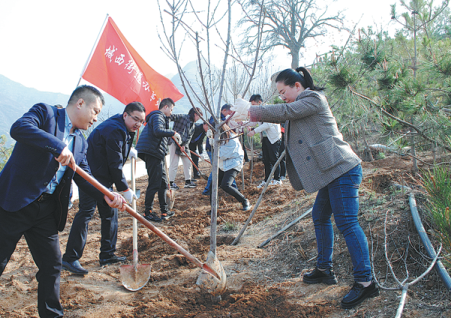Eco focus in Shanxi brings sustainable growth
Updated: 2021-03-19

Volunteers in Yongji, a city in southern Shanxi, plant trees on March 12, China's Tree-Planting Day. [Photo by Zhang Yanting for China Daily]
Volunteers have played an important role in greening Shanxi and contributing to sustainable growth in the province, according to local authorities.
Statistics from the Shanxi Forestry and Grassland Bureau show that volunteers planted 250 million trees during the 13th Five-Year Plan (2016-20) period.
The province planted trees across an area totaling 1.54 million hectares over the five years. This raised its total forest coverage to 23.18 percent at the end of 2019, which surpassed the national average for the first time, according to a recent survey by the bureau.
China's forest coverage stood at 23.04 percent by March 12 this year, according to the National Forestry and Grassland Administration.
Officials at the provincial bureau said Shanxi plans to plant about 330,000 hectares of trees this year. In the next five years, it plans to plant more than 1.3 million hectares of trees. They predict its forest coverage will reach 26 percent by 2025.
In addition to its ecological benefits, the afforestation move in Shanxi has brought new opportunities for farmers to improve their incomes and livelihoods.
According to officials from the Shanxi Forestry and Grassland Bureau, the fragile environment with poor vegetation is one reason for poverty in some regions.
"Natural disasters including sandstorms, water and soil erosion, and floods are usually caused by the lack of vegetation," said an official at the bureau. "These posed major threats to agricultural activities and people's livelihoods over the decades."
Shanxi has implemented innovative reforms for the forestry industry, including compensation for returning farmland to forests and grassland; reforming the ownership and operational mechanism of forests; and encouraging the development of forestry cooperatives.
Forestry cooperatives are among the most popular form of rural cooperatives in Shanxi.
Wu Hailong, a farmer in Runlian village in Jiaokou county, is a member of a local forestry cooperative.
He said before he joined the cooperative in 2017, he lived in poverty because "we used to make a living by working on farms. Life was hard because of the lack of sufficient farmland and the harsh environment with frequent soil erosion during the rainy season".
"The cooperative brings an annual income of more than 30,000 yuan ($4,600) to my family and we were lifted out of poverty in 2018," Wu said.
In Kelan county, cultivation of the wild shrub seabuckthorn has developed into a huge industry benefiting people's livelihoods and the local environment.
While the native shrub has long been used by locals to break winds, stabilize sand and improve soil, it has recently become a major cash crop. Its fruits are rich in vitamin C and can be used to produce herbal teas and other health beverages.
The county is currently home to more than 30,000 hectares of seabuckthorn plantations. A number of enterprises are engaged in growing the plant, and producing and selling related food products.
Wu Jia contributed to this story.



